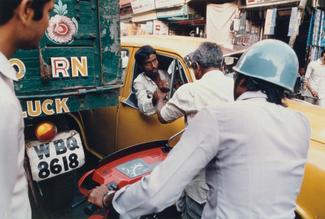
Raghubir Singh. Kolkata Raghubir Singh
Dates : Samedi 9 juillet 2022 - Dimanche 6 novembre 2022
Adresse : Museum Ludwig , Heinrich-Böll-Platz, 50667 Köln
Museum Ludwig
Heinrich-Böll-Platz
50667 Köln
Allemagne
Description, horaires...
The Indian photographer Raghubir Singh (1942–1999) repeatedly returned to Kolkata (called Calcutta until 2001), and over the years he created a complex and multilayered photographic portrait of the city. Having grown up in Jaipur, the capital of the Indian state of Rajasthan, Singh visited Kolkata for the first time in 1975 before he moved to Hong Kong and Paris; later he lived in London and New York. In his street views in particular, Singh condenses Kolkata’s varied impressions into photographs of impressive color and composition. Singh saw these colors as characteristic of the geography and culture of India. He used them to direct the viewer’s attention across the entire picture so that the foreground and background often appear as if on a single plane. In this way, the different historical layers are equally represented in the photograph. Singh’s photographs are a cosmopolitan’s homage to a cosmopolitan city.
In the photography room, the Museum Ludwig is presenting twelve photographs from Singh’s Calcutta series, which have been part of the collection since 2017. They are juxtaposed in the presentation with five photographs by Henri Cartier-Bresson, which he took during his trip to India in 1947. Quotations from Singh’s writings comment on his photographs and those of Cartier-Bresson and illustrate his photographic attitude.
Raghubir Singh began working as a photojournalist for Indian and international publications such as National Geographic, Life, Time, and the New York Times in the 1960s. He discovered Henri Cartier-Bresson’s photography book Beautiful Jaipur as a schoolchild. In 1966 he first met Cartier-Bresson, who had an important influence on his working methods. Like Cartier-Bresson, Singh sought to combine the fleetingness of the moment with compositional rigor. Unlike his role model, however, he decided very early on to use color photography. In his seminal 1998 text “River of Colour: An Indian View,” Singh explained how the appreciation of color is rooted in Indian aesthetics and cultural history, and how color photography was rejected as vulgar by photographers such as Walker Evans in the Western value system. Singh explains that that rasa, the ineffable mental state of fulfillment when viewing a successful artwork, is aimed at a reception of art which mainly relates to color and the atmospheres associated with it. At the same time, seeing does not stand for a distanced perception, as in the Western tradition, but for one that contains the sensuality of the sense of touch and sensus communis. Singh was not interested in using color photography to establish a new style as an answer to the modernist photography of Cartier-Bresson, Andre Kertesz, and Lee Friedlander. Instead, he wanted to shape photography from an Indian perspective. “Western modernism in photography will in time be broadened, by non-Western artists through a fine disregard of the philosophical stance of the West and of the related rules of the game,” Singh believed.
Singh developed a photographic stance around 1980 that made use of the qualities of street photography, such as the snapshot aesthetic and unusual choices of cropping, though without distancing himself from the chosen subjects as “alienated and discarded.” The intensity of Singh’s color photographs stems largely from his ability to give a new twist to modernist photography in this sense.
Singh used cropping to convey everyday situations in public places as distilled events, such as an argument in traffic or trading in front of the stock exchange. A car is centered in a photo of believers celebrating the Durga Puja festival at the Kali temple complex; it becomes synonymous with the religious scene and clashes with its otherwise timeless appearance. In the photograph of a cigarette and tea shop, a partition wall and a raised floor create a construction of a picture in a picture which challenges the viewer to examine the photograph more closely. In many of his photographs, Singh creates an tension between old and new, history and the present, as in the photograph of the courtyard of a stately building, in which the old colonial world of Corinthian columns and a neoclassical depiction of Venus is enlivened with cattle, chickens, and a cat.
The photographs in the Calcutta series attest to Singh’s intimate knowledge of the city and its long history, which was shaped by the Bengali Renaissance, a reform movement of intellectuals in the early nineteenth century who initiated cultural, social, and political change. Among them was the poet, musician, and philosopher Rabindranath Tagore, to whom Singh pays tribute in photographs such as one taken in the former music room in the Gosh family’s house. Another photograph shows two domestic workers listening to a concert of Tagore songs apart from the other guests. Among Singh’s portraits from the Calcutta series on view is a photograph of the filmmaker Satyajit Ray. Singh saw his films as a model for the successful development of the connection between East and West forged by the Bengali Renaissance. In his introduction to the 1988 photography book Calcutta: The Home and the Street, Singh wrote: “Calcutta became a regular destination of mine because there the Bengalis had created a cosmopolitan world.”
Raghubir Singh published thirteen photography books and received numerous awards. Singh’s works are part of the collections of the Metropolitan Museum of Art, the Museum of Modern Art, and Tate Modern, among others.
Curator: Barbara Engelbach